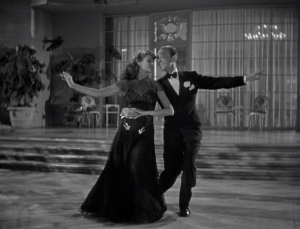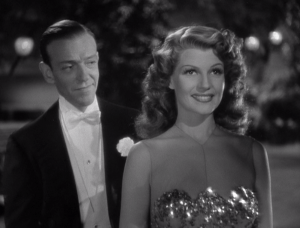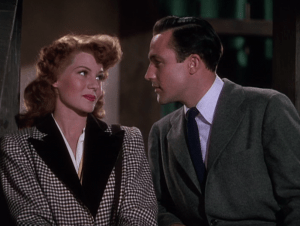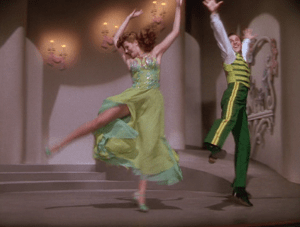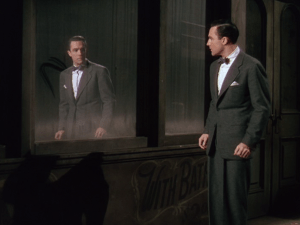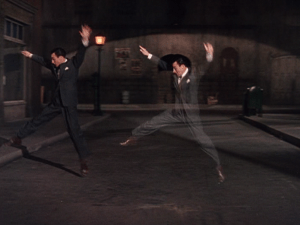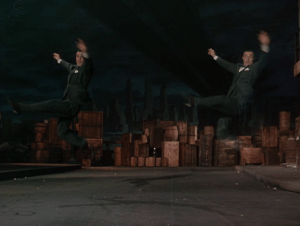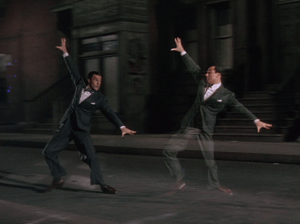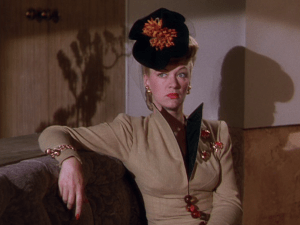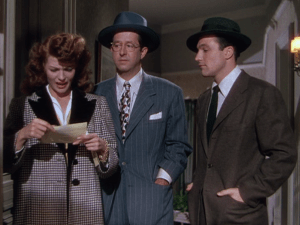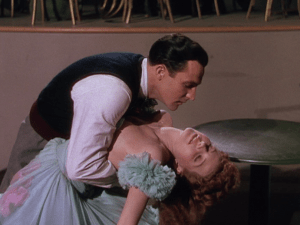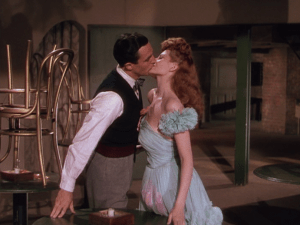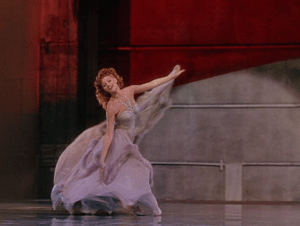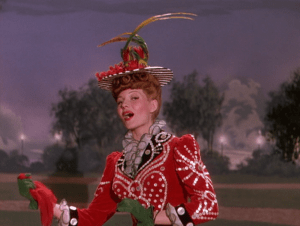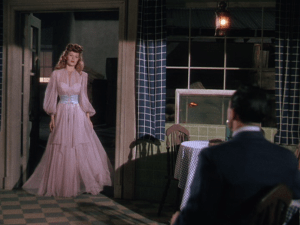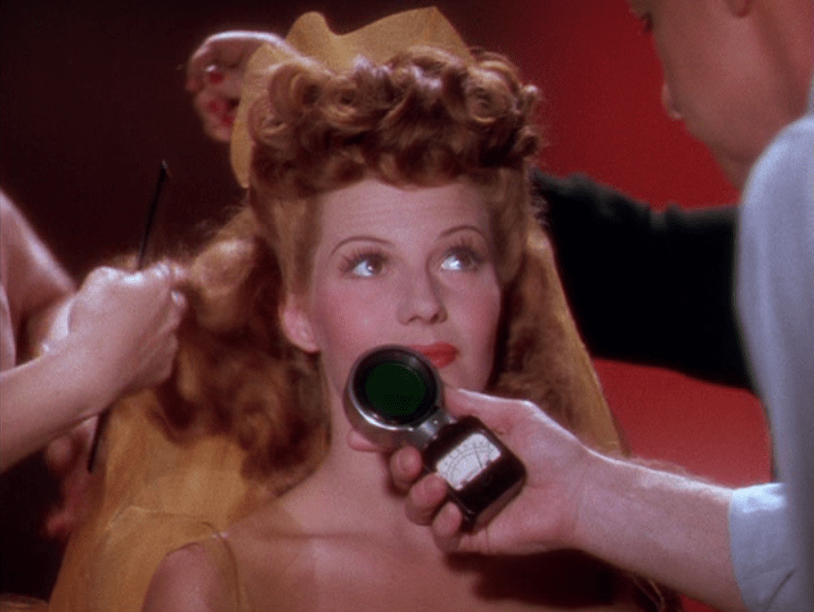
I’m always curious to know how people remember Rita Hayworth. Is it as the woman who was pictured seductively sitting in bed, making thousands of soldiers’ hearts beat faster during WWII? Or is it as Gilda, singing “Put the Blame on Mame” while playfully stripping off her gloves? Or maybe you recall her high-profile marriages to Prince Aly Kahn (making her a princess seven years before Grace Kelly), multi-hyphenate Orson Welles, and singer Dick Haymes. Perhaps all some people remember is her gorgeous red hair and her stunning smile, a combination that proved irresistible to audiences and ultimately labelled Hayworth as “the love goddess.”
Although the actress is definitely one of the most beautiful people you’ll ever see, what I love about her first and foremost is her talent. Don’t let the shallow “love goddess” image fool you — Hayworth wasn’t just a pretty face. Throughout her career, she often played women of mystery, complicated vixens who usually turn out to have hearts of gold. But I must admit my favorite films of Hayworth’s are her musicals. These are the movies where I feel like we are closest to seeing what she was really like. Born Margarita Carmen Cansino to two professional dancers, Hayworth started performing at the age of three. She became her father’s dance partner in the 1930s before making her way to Hollywood, where she was encouraged to change her name and her appearance to be more “American.”
In 1941, Hayworth was cast in her first musical, You’ll Never Get Rich. Her co-star? The legendary Mr. Fred Astaire. Amazingly, Hayworth has no problem matching Astaire tap for tap, and the two were quickly put into their second and final collaboration, You Were Never Lovelier, which I think is the better film. Although Astaire was paired off with many incredible women — Eleanor Powell, Cyd Charisse, Judy Garland, Audrey Hepburn, and, of course, Ginger Rogers being just a few — the icon would privately say that his favorite partner was Hayworth.
As if that wasn’t proof enough that the lady was born for musicals, she was also the first of six women who danced with both Astaire and Gene Kelly. The film that helped give her this high honor was 1944’s Cover Girl, a marvelous Technicolor confection that became Hayworth’s most successful movie in her entire career. It was also immensely important for Kelly. At this time, he wasn’t yet known for his inventive routines and his skillful directing. His home studio, MGM, had no idea what Kelly was capable of… until they loaned him to Columbia for Cover Girl.
For the first time on film, Kelly was able to explore his insane creativity. Director Charles Vidor basically let him have free rein and Columbia allowed him to create his own choreography. The results are overwhelming, particularly the number known as the “Alter Ego Dance.” In the film, Kelly plays Danny, the owner of a rundown nightclub, which employs his girlfriend, Rusty (Hayworth), as a chorus girl. The couple are determined to work their way to fame and fortune based on their talent, but when Rusty finds sudden notoriety after getting put on the cover of a magazine, she and Danny are slowly torn apart.
As he attempts to come to terms with Rusty’s fame and what that means for them, Danny glances at his reflection in a store window only to see it take on a life of its own. The infamous “Alter Ego Dance” is the manifestation of Danny’s inner struggle. It’s also just a genius piece of cinema. Using trick photography to dance with an imaginary version of himself, Kelly endured what he often called his most difficult routine. Thanks to superimposition, he could achieve the appearance of his double, but he also had to dance perfectly as Danny and Danny’s reflection, and he needed to make sure all of this was done without looking too gimmicky or cheesy.
To help him, Kelly brought to the film Stanley Donen, a young man who was in the chorus of Kelly’s breakthrough Broadway show Pal Joey. Donen and Kelly became friends and, starting on Cover Girl, collaborators who would craft some of Hollywood’s best films, like Singin’ in the Rain. Donen helped with Cover Girl‘s choreography and during the “Alter Ego Dance,” he stood by the cameraman and instructed him on the timing of the camera’s movements since he and Kelly wanted fluid shots that moved along the street rather than something static. Charles Vidor actually didn’t believe the number could be done and shut down production! “He never thought you could do that dance,” Kelly recalled. “He laughed and left. So that was great. I had all this freedom.”
I’d be remiss if I didn’t mention the supporting cast that help make Cover Girl as much fun as it is. Comedian Phil Silvers is excellent as Kelly and Hayworth’s best friend. The three of them make for a great trio, especially when they go singing and dancing in the streets for the number “Make Way for Tomorrow.” Otto Kruger and Lee Bowman are wonderful, too, but if I had to pick a true standout, it would be Eve Arden, no question. In the ’40s and ’50s, if you were looking for a second lead with a wisecracking, take-no-prisoners attitude, Arden was your gal. In addition to her hilarious barbs and her wise point-of-view, Arden never looked anything less than exquisite.
The film’s splendid score comes courtesy of two songwriting giants: Jerome Kern and Ira Gershwin. Both men contributed enormously to the Great American Songbook, and with Cover Girl, they added yet another unforgettable song to their repertoire called “Long Ago and Far Away.” The supremely romantic number actually earned an Oscar nomination for Best Original Song, but Johnny Burke and Jimmy Van Heusen took home the award for Going My Way‘s “Swinging on a Star.”
With Cover Girl being a triumph, Columbia bought the rights to Pal Joey and planned on re-teaming Hayworth and Kelly. In an ironic twist, now that Columbia demonstrated what a star Kelly was, MGM didn’t want to loan him out for the project. When Columbia finally did make Pal Joey, it was in 1957 with Kelly’s best friend Frank Sinatra, Kim Novak, and… Rita Hayworth.
As Danny, Kelly is terrific. It’s a character that could easily be misunderstood as mopey and mean, but I see Danny as someone who deeply cares for another person and isn’t quite sure how to handle the curveballs that are thrown at them. It becomes a messy situation, one where both parties are right but they’re also a little wrong.
Throughout the movie, there isn’t a moment where Hayworth doesn’t look luminous. She was a natural entertainer with unwavering charisma and sensuality. Although she was rarely able to use her own singing voice (she was dubbed by Martha Mears in this film), Hayworth could still dance her heart out and her acting was tremendous. The vibrancy and magic she brought with her to the screen all but makes Cover Girl sparkle. “I guess the only jewels of my life were the pictures I made with Fred Astaire,” Hayworth said in 1970. “And Cover Girl, too.”
Cover Girl will be screened at the IU Cinema on January 29th, kicking off this semester’s Monday Matinee Classics series.
The Cinema has shown some of Gene Kelly’s finest films, including Singin’ in the Rain in 2014, An American in Paris in 2017, and The Young Girls of Rochefort in 2014, a screening that was part of actor George Chakiris’s visit to the Cinema.
In 2014, the Cinema also screened one of Hayworth’s best movies, The Lady from Shanghai, a fantastically twisty film noir directed by and co-starring Hayworth’s then-husband Orson Welles.

Michaela Owens is thrilled to be the editor of A Place for Film. An IU graduate with a BA in Communication and Culture, Michaela has also been a volunteer usher at IU Cinema since 2016. She never stops thinking about classic Hollywood, thanks to her mother’s introduction to it, and she likes to believe she is an expert on Katharine Hepburn.
